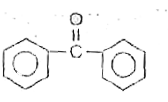Iodoform reaction is given by


CH3−CH2−CHO
All of these
The correct Answer is:A
To solve the question regarding the iodoform reaction, we need to understand the conditions and requirements for a compound to undergo this reaction. The iodoform reaction is specifically characteristic of certain types of compounds, particularly those containing a methyl ketone or a primary alcohol that can be oxidized to a methyl ketone.
1. Identify the Requirements for Iodoform Reaction:
The iodoform reaction occurs with compounds that have the structure RCOCH3 (methyl ketones) or compounds that can be oxidized to this structure. This means we are looking for a carbonyl group (C=O) adjacent to a methyl group (CH3).
2. Reagents Involved:
The reaction involves iodine (I2) and sodium hydroxide (NaOH). When these reagents are present, they react with the suitable compounds to form iodoform (CHI3), which is a yellow precipitate.
3. Mechanism of the Reaction:
- The base (NaOH) abstracts an alpha hydrogen from the methyl group adjacent to the carbonyl, forming an enolate ion.
- This enolate ion then reacts with iodine to form an iodo compound.
- The process repeats, leading to the formation of triiodomethane (CHI3) and a carboxylate ion.
4. Final Product:
The final product of the iodoform reaction is triiodomethane (CHI3), which is characterized by its yellow color.
5. Identifying Compounds that Undergo the Reaction:
To determine which compounds will give the iodoform reaction, we must check each option provided in the question to see if they contain the required RCOCH3 structure or can be oxidized to it.
6. Conclusion:
After analyzing the options, the correct answer will be the compound that contains the methyl ketone structure or can be oxidized to it.
The iodoform reaction occurs with compounds that have the structure RCOCH3 (methyl ketones) or compounds that can be oxidized to this structure. This means we are looking for a carbonyl group (C=O) adjacent to a methyl group (CH3).
The reaction involves iodine (I2) and sodium hydroxide (NaOH). When these reagents are present, they react with the suitable compounds to form iodoform (CHI3), which is a yellow precipitate.
- The base (NaOH) abstracts an alpha hydrogen from the methyl group adjacent to the carbonyl, forming an enolate ion.
- This enolate ion then reacts with iodine to form an iodo compound.
- The process repeats, leading to the formation of triiodomethane (CHI3) and a carboxylate ion.
The final product of the iodoform reaction is triiodomethane (CHI3), which is characterized by its yellow color.
To determine which compounds will give the iodoform reaction, we must check each option provided in the question to see if they contain the required RCOCH3 structure or can be oxidized to it.
After analyzing the options, the correct answer will be the compound that contains the methyl ketone structure or can be oxidized to it.
Similar Questions
Knowledge Check
- Question 1 - Select One
Iodoform reaction is shown by
ACH3CH2CH2CH(OH)CH3BC2H5OC2H5CCH3CH2CH2CH2OHD(CH3)3COH - Question 2 - Select One
Iodoform reaction is used to detect
AHCO groupBC6H5CHOCCH3C6H4CHODCH3CHO - Question 3 - Select One
Iodoform test is not given by :
A2 - PentanolB3 - PentanolCEthanolDEthanal.

